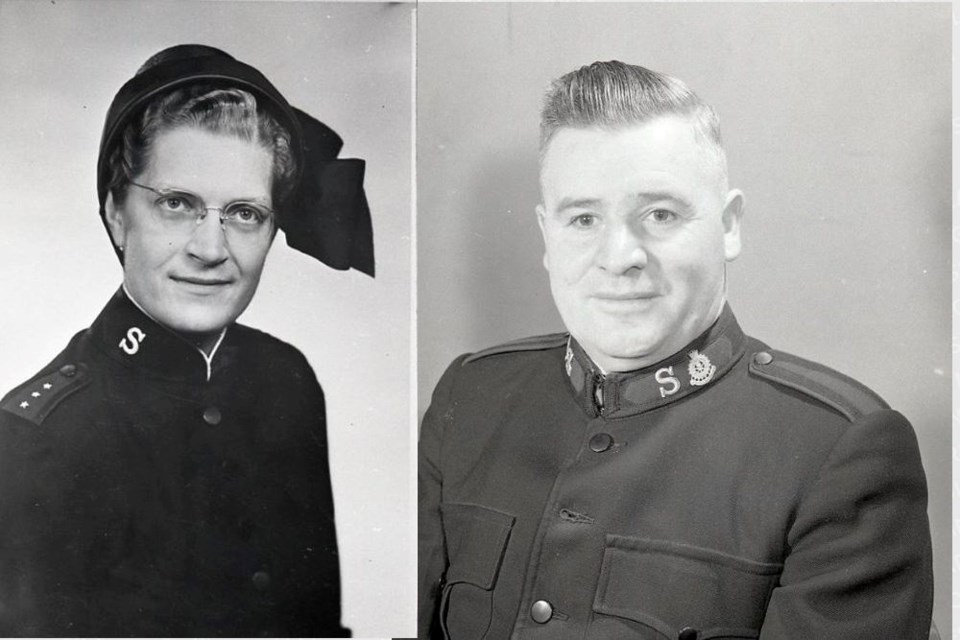From the archives of the Sault Ste. Marie Public Library:
Whenever the Salvation Army is mentioned it probably brings to mind a number of different thoughts for each person.
Although the “army” may mean different things to different people, their focus has always been on finding ways to help other people.
The Salvation Army is a Christian society that began in London, England in the mid-1850s to battle against “sin, drink and poverty” in the London slums.
Gaining respect for their efforts to help other people, they gradually expanded around the world to become known as a ‘spiritual organization with a social conscience, combining religion with social work.’ With a structure that mimics the British military, the members are referred to as soldiers and the officers use the same titles as the military.
In Sault Ste. Marie, the group’s first meeting was held on April 9, 1894, and was led by Captain Agnes Worr. This meeting was held outdoors but a tent was later erected on a vacant lot on the northwest corner of Queen and Elgin Streets (where the Cochrane-Dunlop Building would later be built).
It was thought that an outdoor meeting would appeal to people who would not attend a church building.
From this humble beginning, Captain Worr continued to try to strengthen the Salvation Army and get it established locally but after facing many difficulties the work was suspended in 1897.
After about five years, Captain John LeCouq reopened the army work. One of the first tasks in 1902 was to erect a permanent structure on Spring Street, which was known as a barracks. This first building, built at a cost of $5,000, was then demolished to make way for its replacement in 1912, located just south of the original barracks. The cost for the new Citadel was $18,500.
In 1903, a Corps was established in Steelton under the leadership of Captain Edith Meader. The Steelton Corps met in a variety of locations including the West End (Steelton) Public Library before finding a more permanent location on Wellington Street.
In addition to being a permanent meeting space for the Corps, the Spring Street Citadel provided some much-needed space that they could use to provide assistance to those in the city who were in need, either for meals, clothes or toys for the children. However, by the 1960s, it was clear that they needed more space so plans were made to find a new location and begin the process of building a new Citadel.
Land was found on John Street and plans were drawn up. On April 15, 1967, Jerry Ryckman, Chairman of the Building Committee was photographed at the sod-turning ceremony and construction began immediately.
The new Salvation Army Citadel held its official opening in January 1968. With the new building in place, the Sault Ste. Marie and Steelton Corps officially amalgamated in 1970.
The old citadel on Spring Street was kept open as a social centre, drop-in club and food bank. The thrift shop was also moved there from Brock Street. In August of 1996, the building was put on the market and a new location for both the thrift store and the food bank was sought.
A familiar sight at Christmas time is the Salvation Army kettles - but do you know how they started?
According to a Sault Star article from Dec. 24, 1963, a shipwreck occurred near San Francisco in 1894. The Salvation Army was looking after the survivors when their food supplies began to run out.
A female member grabbed a soup kettle and headed out to a busy street corner and put up a sign saying, “Keep the Kettle Boiling.”
People appreciated her efforts and began dropping coins into the kettle. She was able to collect enough money to acquire more food for the survivors. Following this successful endeavour, the kettle became an ongoing symbol for the Salvation Army Christmas efforts as they continued to help the needy.
The money raised was used to create Christmas hampers for needy families. Once their physical needs were met, toys were found for the children.
Another of the fundraising methods used is the annual Red Shield Campaign which is held during the month of May, and throughout the years the local Citadel has conducted many successful campaigns. Money raised during the past years has been used to help with disaster relief for victims of fire, flood or other disasters as well as food and clothing support.
In addition to its efforts on behalf of the needy, the Salvation Army has always been well-known for its music.
The Salvation Army Band helped to build Christmas cheer by playing Christmas carols and getting people into the Christmas spirit. Both the band and the kettle became familiar sights on the streets of Sault Ste. Marie before Christmas.
In addition to the Salvation Army Band, the Steelton Quartet grew in popularity with their gospel singing. Formed in 1961, the original group consisted of three brothers, Garfield, Jerry and Bob Ryckman along with Stan Metcalf. With a few changes in the members during the 1970s, the group eventually formed to include John Evans, Darrell Collar, Bob Ryckman and Garfield Ryckman.
The quartet continued to sing and entertain the residents of Sault Ste. Marie, as well as to audiences across Canada and the United States, until concluding their music concerts with their farewell concert in February 1983.
Even though the world may have experienced a lot of changes over the years, the Salvation Army’s message remains the same, they find practical ways to help those in need in the community both physically and spiritually.
Each week, the Sault Ste. Marie Public Library and its Archives provides SooToday readers with a glimpse of the city’s past.
Find out more of what the Public Library has to offer at www.ssmpl.ca and look for more Remember This? columns here
